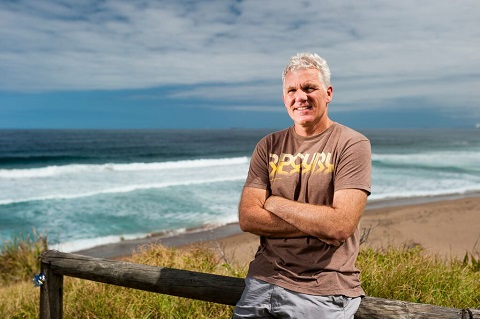Cool job: Surf scientist
Yes, Rob Brander (BSc 1989 UTSC, MSc 1991) is a professor of coastal geomorphology at the University of New South Wales in Sydney, Australia. But he’s best known as Dr. Rip, the expert warning people around the world about the perils of rip currents through his bestseller Dr. Rip’s Essential Beach Book and popular YouTube videos.
Did you grow up by a beach?
I grew up in Bay Ridges, a suburb of Pickering, and the beach was just down the road – but so was the nuclear plant! The water was cold and polluted, and my real love of the beach came from our yearly family holiday to Cape Cod.
How did you go from studying geography to saving lives?
Shortly after I finished my PhD on rip currents, I witnessed several drownings that could easily have been avoided if the victims had had even a basic knowledge of rips. It really bothered me when I realized I had that knowledge and it wasn’t helping anybody, so I started the Science of the Surf program to educate people about rips.
What are rips?
Rip currents are like rivers of the sea. They are strong, narrow currents that typically flow at speeds faster than people can swim.
To avoid rips, you need to look for green gaps, like paths, heading out through the surf. It’s good to think of green as mean because it signals deeper water that could be over your head and may be a rip current. White is nice because white water means it’s shallow; you can probably stand up.
What should you do if you get caught in one?
Don’t panic. Rips won’t pull you under. They just take you for a ride and will often bring you in a semi-circle back into shallow water in just a few minutes. It’s panic that drowns people, not rips. Just go with the flow, relax and signal for help if there are lifeguards or surfers around.

Sharks get a lot of press. Are rip currents more dangerous than sharks?
Absolutely! The media loves sharks – shark attacks sell papers, and shark hysteria preys on primal fears. Worldwide, the average number of shark fatalities is about five per year. Globally, hundreds of people per year drown in rips, but they don’t generate media attention. In Australia, the average is 20 rip drownings per year and in the U.S. it’s about 100.
Do Toronto swimmers need to worry?
There are rips in the Great Lakes, particularly next to piers and similar structures, but usually only during storms when conditions aren’t great for swimming. For Canadians, rips are more of an issue when they go on vacation. Plenty of beaches in the U.S., Caribbean and Mexico have rips and, unfortunately, there are many instances of Canadian tourists drowning in rips while on holidays.
Do you live by a beach now?
There’s no way I’m going to be in Australia and not live at the beach! Hands-down, we have the best beaches in the world. I’m passionate about bodysurfing, which I think is the purest form of surfing. And with two young girls, building sandcastles is making a comeback in my life, and it’s just as much fun as it was when I was a kid.
Watch: Dr. Rip’s award-winning How to survive beach rip currents:
Recent Posts
For Greener Buildings, We Need to Rethink How We Construct Them
To meet its pledge to be carbon neutral by 2050, Canada needs to cut emissions from the construction industry. Architecture prof Kelly Doran has ideas
U of T’s 197th Birthday Quiz
Test your knowledge of all things U of T in honour of the university’s 197th anniversary on March 15!
Are Cold Plunges Good for You?
Research suggests they are, in three ways






2 Responses to “ Surf Scientist ”
Right now, building sand castles are still popular with our son when we visit Australia, but we're pretty sure surfing will be a big hit on future visits as he gets older. So thanks for this article and for posting Dr. Rip's Youtube video on rip currents. I didn't know anything about rips and now I feel better prepared the next time we hit an ocean beach.
What an amazing job Mr. Brander has - and to be able to put his knowledge to such good use in Australia and around the world, thanks to social media, is just fantastic.
I'm Australian. My brothers and I knew not to panic in rips when we were kids. We used to ride the rip out then ride it back, then walk back along the beach. We also used to ride waves back in when the shark alarm sounded, wait for the all-clear, then go back in. I used to live in Canada, and love Canadians, but they didn't invent this particular wheel.